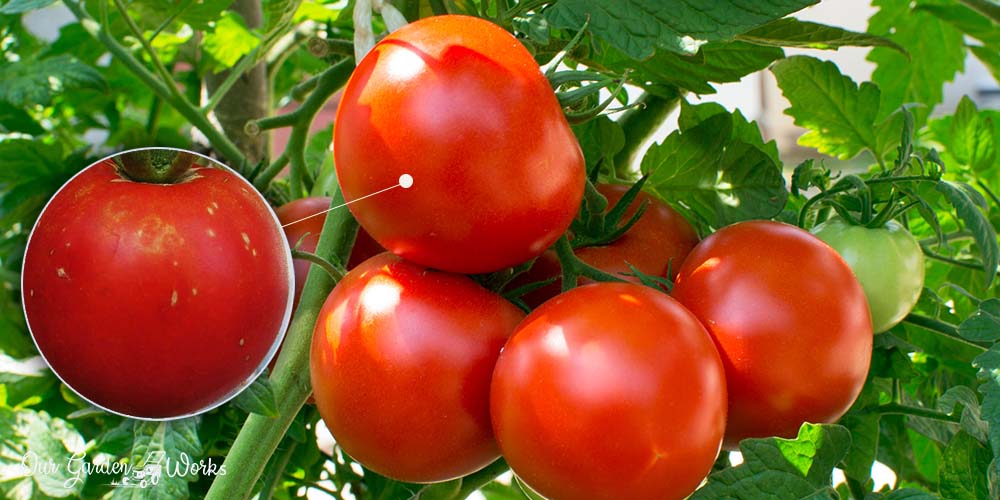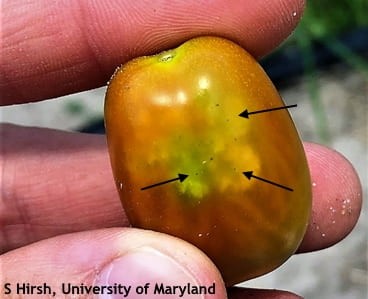Seeing white spots on tomatoes, either on their fruits or leaves, can be very frustrating for every gardener.
If you have been growing tomatoes for quite a while now, you would notice that they are quite a magnet for pests and diseases. If you are not familiar with the common pests and diseases, it can be hard to identify which is wreaking havoc on your plants.
Let this post help you figure out what is causing the white spots on tomatoes and find a solution as early as possible.
Who knows, you might save your other tomato plants from a pest infestation or disease and enjoy a bountiful harvest during this growing season.
4 Causes of White Spots on Tomatoes
Pests, diseases, nutrient deficiency, and certain environmental factors can cause white spots on tomatoes. We will discuss them by category with respective treatments and courses of action.
Let’s start with the common culprit of tomato damages – pest damage!
1. Pest Damage

Tomatoes with white fibrous spots near the skin are caused by stinkbug feeding.
The brown marmorated stinkbug is a type of pest that targets juicy fruits like peaches and tomatoes. It has a needle-like mouthpiece that is used to puncture the skin of tomatoes and suck on the juice inside the fruit.
According to Auburn University, the mouthpiece of stinkbugs inserted underneath the skin of mature tomato fruits comes with toxins or yeast infections that clump the affected area.
The rest of the fruit will continue to develop and receive water from the plant but not for the area where the stinkbug fed, causing it to turn white, tough, and fibrous
In worse cases, stinkbugs prevent young tomato fruits from developing and medium-sized ones will have some scars on their skin. They can also inject digestive enzymes into the fruit to dissolve seeds and continue feeding.
The affected tomato fruit with spots caused by stinkbugs can still be eaten since the damage is only on the cosmetic. Stinkbug feeding doesn’t alter the taste and you can opt to cut out the affected part if you prefer it that way.
How to Get Rid of Stinkbugs on Tomatoes?
You have three options in keeping stinkbugs and other pests away from your tomatoes. These include:
- Handpick the stinkbugs: Stinkbugs and leaf-footed bugs are prone to gather in one location when they feed. So, it can be easy for you to collect a group of stinkbugs feeding on tomato fruits or leaves. They may also hide in clusters of fruits and the underside of the leaves. Put the collected stinkbugs in a container with soapy water.
- Use a homemade insect spray: The best solution for pests is to smother them with a combination of mineral oil and water. Spray the whole plant with your DIY pest spray after the sun has set to keep the bugs away. Avoid applying oil-based pest sprays when the sun is up to avoid burning your tomato plants.
- Apply organic pesticides: If the first two options do not decrease the stinkbug infestation in your tomato plants, it’s best to use a stronger solution. You can use tomato insecticides best for the type of infestation that you have such as neem oil.
2. Bacterial Infection
One of the worst causes of white spots in tomatoes is the bacterial canker.
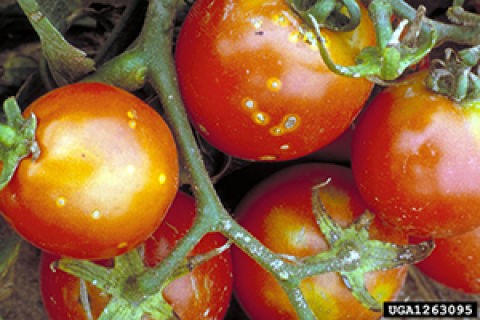
It is a bacterial infection that doesn’t immediately show symptoms until it has already spread throughout the plant. It can kill tomato seedlings and damage mature tomato plants and their fruits.
The pathogens of bacterial canker of tomato can survive on weeds. If you have a ton of weeds around, it might be the cause of white spots on your tomatoes.
However, other symptoms also affect the leaves and the stem of the tomato plant, including:
- Leaves are turning brown and yellow
- Sunken veins on leaves
- Lower leaves are wilted
- Brown streaks on the stem
- A yellow substance comes out of the stem when cut
- The surface of the fruits are netted
The pathogens of this bacterial disease can be spread by the wind and splashes of water. It spreads during warm seasons in temperatures ranging from 75°F to 90°F. It can also stay in the soil and spread on the lower leaves through water splashes.
Bacterial canker of tomatoes can contaminate your gardening tools, stakes, and undecomposed tomato plant from several months up to 3 years. It can also transfer to your other plants, especially peppers.
Sadly, there is no known treatment for bacterial canker in tomatoes. You can only manage the spread of the pathogens and prevent the occurrence of this bacterial infection by following these tips:
- Once you notice that your tomatoes have bacterial canker, sanitize all your hands, gardening tools, and equipment with a diluted bleach solution.
- Only buy from suppliers with pathogen-free tomato seeds.
- Do not re-use anything from the infected plant unless it’s for heat composting.
- Do not re-use the wooden stakes of the infected plants.
- Do not work on your garden when the area is wet to avoid the unintended spread of pathogens.
- Always weed your plant beds since the pathogens of bacterial cankers can live in them.
3. Fungal Disease
If the white spots on tomato leaves are fuzzy and moldy, then you might be dealing with powdery mildew.
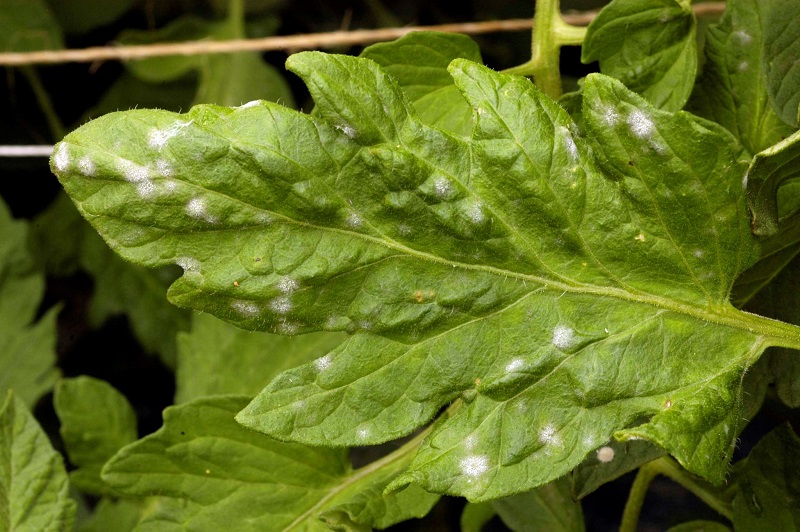
Oidium Lycopersicum is a type of powdery mildew that causes white fuzzy spots on top of the leaves and stems of plants.
Powdery mildew is a fungal disease that loves the humid and warm environment from 59°F-80.6°F and commonly spreads during spring and summer. It has pathogens that can stay in the soil and spread by the wind.
In severe cases, it can disrupt the growth of your tomatoes and affect the quality of their fruits.
Tomatoes that are placed in shady areas and have no air circulation are most likely to develop powdery mildew.
The disease usually starts from the lower leaves and works its way up to the other parts of the plant. Young leaves affected by white spots caused by powdery mildew can cause the leaves to curl, be yellow, dry, and disfigured.
If you caught the disease early, you can still save your tomatoes. As time goes, the spots will grow and cover almost all of the leaves, stems, and fruits. From that point, your tomatoes will be beyond saving.
That is why it’s crucial to keep an eye on applying preventive fungicide and always keeping the water off the leaves.
How to treat powdery mildew on tomatoes?
Treating a fungal disease in plants is like handing glitters. The pathogens and spores of the fungus can get onto anything that comes in contact with it.
Here are awesome tips to control the spread of powdery mildew:
- Remove all infected leaves and discard heavily infected tomato plants since they will be beyond saving.
- Make preventive fungicides a part of your planting routine.
- Always wash your garden tools.
- Avoid splashing water and foliar watering on your tomatoes. Wet leaves only attract pests and spores onto the leaves.
- Heavily infected tomato plants can be hard to save. So, instead of reviving them, you should put all your efforts into controlling the spread of the spores.
- Do not put the infected leaves and plants in your compost pile. Either burn them or put them in the trash to avoid the unintended spread of fungus spores.
- Mulch your tomatoes to prevent soil-borne diseases from reaching the lower leaves of your plants. Mulch also helps your plants preserve moisture during the warm season.
4. Environmental Factors
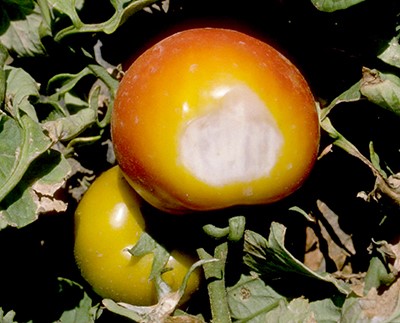
Though tomatoes love the sun, too much heat can also cause them damage. Sunscald is a condition in tomatoes where too much direct sun can cause white spots or blotches in tomato fruits.
It usually happens when the sun rays are too much for the plant to handle like tomatoes recovering from a pest infestation or diseases.
Sunscald is common to developing fruits and becomes sunken as the fruits develop. However, the sunken part can end up rotting or be taken advantage of by lurking plant diseases. Aside from tomatoes, it can also happen to peppers.
The appearance of tomatoes is affected and the taste will also change as soon as the affected parts develop a black mold or another plant disease.
Here are some of the tips to prevent your tomatoes from getting sunscald:
- Keep your tomato fruits in the shade.
- Don’t let the spores stand a chance
- Apply mulch
- Always clean and sanitize your garden tools
- Prefer soil drenching over foliar watering
Is It Safe To Eat Tomatoes with White Spots?
You might be having second thoughts about using the damaged fruits of your tomato plants cosmetic-wise.
Here’s some safety guide in eating damaged tomatoes:
- Pest damage: Tomatoes damaged by brown stinkbugs are still edible. The white fibrous spots can be tough to eat so you can just slice them off and eat the rest of the fruit. The taste will still be the same so it will be quite a waste if you throw the whole fruit out.
- Bacterial canker of tomatoes: Tomatoes infected with bacterial canker have no known harm to humans when cooked. However, the acidity of the fruit is affected and therefore makes it not suitable for canning and as a preservative.
- Fungal diseases: Tomatoes infected with diseases are still edible and safe to eat. However, some people might be allergic to powdery mildew.
- Sunscald: Tomatoes damaged by the strong rays of the sun should be harvested early on and let ripen indoors. Doing so can prevent the affected fruit from developing diseases like black mold.
Frequently Asked Questions (FAQs)
What is the best fungicide for tomatoes?
Like insecticides, no fungicide is a one-size-fits-all solution for tomatoes. But each type of fungicide is good in treating certain plant diseases.
Here’s a list of best fungicides for tomatoes along with the specific disease that they can effectively treat:
- Bonide Mancozeb Fungicide Concentrate (Tomato leaf spot)
- Southern Ag Liquid Copper Fungicide (Early tomato blight and late tomato blight)
- Bonide Copper Fungicide Ready-To-Use (Early tomato blight )
- Garden Safe Fungicide Ready-To-Use (Powdery mildew)
- Spectracide Immunox Fungicide Spray Concentrate (Downy mildew)
- Neem Bliss Neem Oil Fungicide (Powdery mildew)
- Daconil Fungicide Concentrate (Septoria Leaf Spot)
- Serenade Garden Fungicide (Fusarium wilt and verticillium wilt)
- Mycostop WP Biofungicide 2 Gram (Fusarium wilt)
- Dr. Earth Ready to Use Disease Control Fungicide (Downy mildew)
What does baking soda do for tomato plants?
Baking soda can lower the acidity in the soil and be used as a treatment for certain fungal diseases like powdery mildew.
To use it as a homemade fungicide, mix 4 cups of water, one cup of milk, and a teaspoon of baking soda. Mix it well and apply it to the disease-affected part of your plants.
Will vinegar kill bugs on tomato plants?
Vinegar is one of the most available ingredients for a homemade pest spray. The smell of vinegar can’t kill but can only drive away insects and other pests away from your plants. Plus, they are organic and inexpensive.
What does Epsom salt do to tomatoes?
Some gardeners use Epsom salt to boost the fruit production of tomatoes. Epsom salt contains magnesium and sulfate and contributes to the chlorophyll production of plants. The micronutrients in Epsom salt help improve the health, taste, and quality of tomatoes.
Will powdery mildew go away?
Mild cases of powdery mildew can go away on their own. However, severe cases and the continuous spread of powdery spots all over the leaves and stem can disrupt the plant’s processes. If severe powdery mildew in tomatoes is left untreated, it can cause the plant to wilt and eventually die.
Final Thoughts
Did you find out the cause of white spots in your tomatoes in this post?
If yes, we hope that you’ll be able to find the best treatment to save your tomato plants. Either it is a pest infestation or a fungal disease, leaving the white spots untreated can only get worse.
Do something for your tomatoes and keep them safe as soon as possible. If you find this post informative, please don’t forget to share this with your friends and family. May your tomatoes grant you a bountiful and damage-free harvest going forward.
